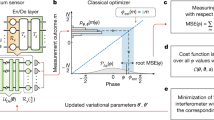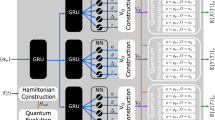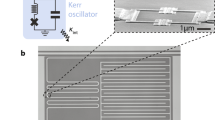Abstract
Quantum measurement has challenged physicists for almost a century. Classically, there is no lower bound on the noise a measurement may add. Quantum mechanically, however, measuring a system necessarily perturbs it. When applied to electrical amplifiers, this means that improved sensitivity requires increased backaction that itself contributes noise. The result is a strict quantum limit on added amplifier noise1,2,3,4,5,6. To approach this limit, a quantum-limited amplifier must possess an ideal balance between sensitivity and backaction; furthermore, its noise must dominate that of subsequent classical amplifiers7. Here, we report the first complete and quantitative measurement of the quantum noise of a superconducting single-electron transistor (S-SET) near a double Cooper-pair resonance predicted to have the right combination of sensitivity and backaction8. A simultaneous measurement of our S-SET’s charge sensitivity indicates that it operates within a factor of 3.6 of the quantum limit, a fourfold improvement over the nearest comparable results9.
This is a preview of subscription content, access via your institution
Access options
Subscribe to this journal
Receive 12 print issues and online access
$259.00 per year
only $21.58 per issue
Buy this article
- Purchase on SpringerLink
- Instant access to full article PDF
Prices may be subject to local taxes which are calculated during checkout




Similar content being viewed by others
References
Korotkov, A. N. Continuous quantum measurement of a double dot. Phys. Rev. B 60, 5737–5742 (1999).
Devoret, M. H. & Schoelkopf, R. J. Amplifying quantum signals with the single-electron transistor. Nature 406, 1039–1046 (2000).
Makhlin, Yu., Schön, G. & Shnirman, A. Quantum-state engineering with Josephson-junction devices. Rev. Mod. Phys. 73, 357–400 (2001).
Clerk, A. A., Girvin, S. M. & Stone, A. D. Quantum-limited measurement and information in mesoscopic detectors. Phys. Rev. B 67, 165324 (2003).
Caves, C. M. Quantum limits on noise in linear amplifiers. Phys. Rev. D 26, 1817–1839 (1982).
Gardiner, C. W. & Zoller, P. Quantum Noise (Springer, 2000).
Korotkov, A. N. Nonideal quantum detectors in Bayesian formalism. Phys. Rev. B 67, 235408 (2003).
Clerk, A. A., Girvin, S. M., Nguyen, A. K. & Stone, A. D. Resonant Cooper pair tunneling: Quantum noise and measurement characteristics. Phys. Rev. Lett. 89, 176804 (2002).
Naik, A. et al. Cooling a nanomechanical resonator with quantum back-action. Nature 443, 193–196 (2006).
Schoelkopf, R. J., Clerk, A. A., Girvin, S. M., Lehnert, K. W. & Devoret, M. H. in Quantum Noise in Mesoscopic Physics (ed. Nazarov, Yu. V.) 175–203 (Kluwer, 2003).
Xue, W. W. et al. On-chip matching networks for radio-frequency single-electron transistors. Appl. Phys. Lett. 91, 093511 (2007).
Schoelkopf, R. J., Wahlgren, P., Kozhevnikov, A. A., Delsing, P. & Prober, D. E. The radio-frequency single-electron transistor (RF-SET): A fast and ultrasensitive electrometer. Science 280, 1238–1242 (1998).
Mozyrsky, D. & Martin, I. Quantum-classical transition induced by electrical measurement. Phys. Rev. Lett. 89, 018301 (2002).
Blencowe, M. P., Imbers, J. & Armour, A. D. Dynamics of a nanomechanical resonator coupled to a superconducting single-electron transistor. New J. Phys. 7, 236 (2005).
Clerk, A. A. & Bennett, S. Quantum nanoelectromechanics with electrons, quasi-particles, and Cooper pairs: Effective bath descriptions and strong feedback effects. New J. Phys. 7, 238 (2005).
Deblock, R., Onac, E., Gurevich, L. & Kouwenhoven, L. P. Detection of quantum noise from an electrically driven two-level system. Science 301, 203–206 (2003).
Billangeon, P., Pierre, F., Bouchiat, H. & Deblock, R. Emission and absorption asymmetry in the quantum noise of a Josephson junction. Phys. Rev. Lett. 96, 136804 (2006).
Gustavsson, S. et al. Frequency-selective single photon detection using a double quantum dot. Phys. Rev. Lett. 99, 206804 (2007).
Fulton, T. A., Gammel, P. L., Bishop, D. J., Dunkleberger, L. N. & Dolan, G. J. Observation of combined Josephson and charging effects in small tunnel junctions. Phys. Rev. Lett. 63, 1307–1310 (1989).
Thalakulam, M., Ji, Z. & Rimberg, A. J. Sensitivity and linearity of superconducting radio-frequency single-electron transistors: Effects of quantum charge fluctuations. Phys. Rev. Lett. 93, 066804 (2004).
Lu, W., Maranowski, K. D. & Rimberg, A. J. Charge transport processes in a superconducting single-electron transistor coupled to a microstrip transmission line. Phys. Rev. B 65, 060501 (2002).
Shnirman, A. & Schön, G. Quantum measurements performed with a single-electron transistor. Phys. Rev. B 57, 15400–15407 (1998).
Choi, M. S., Plastina, F. & Fazio, R. Shot noise for resonant Cooper pair tunneling. Phys. Rev. Lett. 87, 116601 (2001).
Brenning, H., Kafanov, S., Duty, T., Kubatkin, S. & Delsing, P. An ultrasensitive radio frequency single electron transistor working up to 4.2 K. J. Appl. Phys. 100, 114321 (2006).
Maassen van den Brink, A. Quantum-efficient charge detection using a single-electron transistor. Europhys. Lett. 58, 562–568 (2002).
Aassime, A., Gunnarsson, D., Bladh, K., Delsing, P. & Schoelkopf, R. Radio-frequency single-electron transistor: Toward the shot noise limit. Appl. Phys. Lett. 79, 4031–4033 (2001).
Acknowledgements
This work was supported by the ARO under Agreement No. W911NF-06-1-0312, by the NSF under Grant Nos DMR-0804488 and DMR-0804477 and by the NSA, LPS and ARO under Agreement No. W911-NF-08-1-0482. We thank T. J. Gilheart, M. Bal and F. Chen for experimental assistance.
Author information
Authors and Affiliations
Contributions
A.J.R. planned the experiment. W.W.X. and Z.J. fabricated the samples. W.W.X. carried out the measurements with assistance from Z.J., F.P. and J.S. M.P.B. proposed the method of analysis. W.W.X. and A.J.R. analysed the data. A.J.R. and J.S. wrote the paper with input from W.W.X. and M.P.B.
Corresponding author
Supplementary information
Supplementary Information
Supplementary Information (PDF 245 kb)
Rights and permissions
About this article
Cite this article
Xue, W., Ji, Z., Pan, F. et al. Measurement of quantum noise in a single-electron transistor near the quantum limit. Nature Phys 5, 660–664 (2009). https://doi.org/10.1038/nphys1339
Received:
Accepted:
Published:
Issue date:
DOI: https://doi.org/10.1038/nphys1339
This article is cited by
-
Measurement of finite-frequency current statistics in a single-electron transistor
Nature Communications (2012)
-
Local probing of propagating acoustic waves in a gigahertz echo chamber
Nature Physics (2012)



